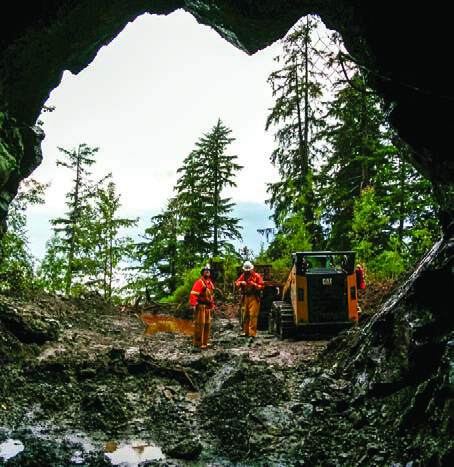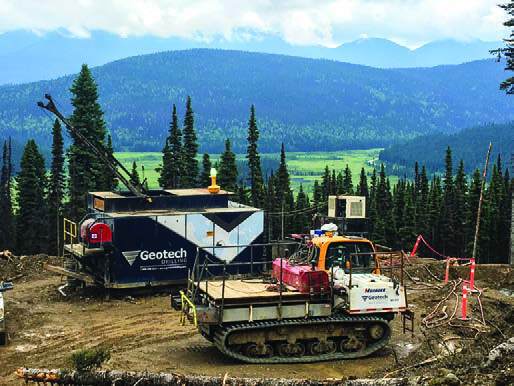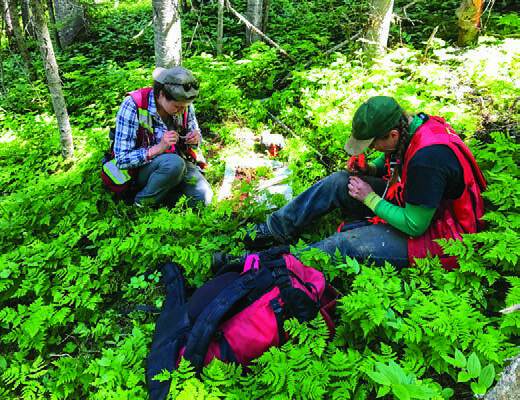
Landing on a flagship roperty: Snip and its airstrip. 
Drilling in the historic Cariboo Gold Belt. 
Environmental work for Barkerville Gold Mines.
Recent exploration projects in British Columbia have taken place at sites that have previously experienced exploration and/ or mining. This article looks at how such previous activity has influenced and benefited Barkerville Gold Mines and Skeena Resources Limited. It also investigates the interface between historical workings and First Nations experience and expertise.
Barkerville Gold Mines
Barkerville Gold Mines’ (BGM) properties comprise roughly 182,222 hectares across a belt 67 kilometres long by 25 kilometres wide. The area includes 101 creeks reporting placer gold production and five past-producing mines. The area is part of the Cariboo Gold Belt, which has attracted investment since the Cariboo Gold Rush of 1861. Historical estimates suggest gold production in the Cariboo Gold Belt of approximately 3.2 million ounces from alluvial production and 1.3 million ounces from lode mines.
Maggie Layman, BGM’s exploration manager, explains the importance of past exploration and working: “Exploration in the Barkerville area dates back to the [1860s] Cariboo Gold Rush and the discovery of the Cariboo Gold Quartz Mine in 1929, which is now known as Cow Mountain.
“In 2016, we gained access to historical mine workings at both Cow Mountain and Mosquito Creek at Island Mountain, where significant structural mapping and geological sampling took place and aided in our interpretation of the geologic model and gold mineralization controls. This work, in conjunction with re-logging over 55,000 metres of historic[al] drill core, enabled us to come up with a sound geologic model to generate targets and advance our exploration program to 10 drills.”
At present, BGM is exploring and delineating with six diamond drills on the Island Mountain Shaft Zone, three drills on the Valley Zone and a 10th drill currently expanding known mineralization on the BC Vein. A total of 140,000 metres will be drilled this year.
BGM’s mineralized veins are vertically dipping and are typically drilled to a vertical depth of about 550 metres; many veins are open at depth and will be explored in the future with underground drilling methods. Recent drilling highlights include 18.84 grams per tonne gold over 30.85 metres at the Shaft Zone in hole IM-17-024. This intersection occurred 20 metres down dip of hole IM-17-078, which intersected 11.42 g/t gold over 28.55 metres. More recent Valley Zone intersections include 10.94 g/t gold over 7.85 metres in hole CM-17-023.
BGM confirmed that it continues to discover new mineralized vein corridors and to expand existing veins at both the Shaft and Valley zones.
BGM has been greatly helped by the involvement of local First Nations. Says Layman, “First Nations engagement is very important to BGM’s exploration activities and mining operations. Engagement is an ongoing process with the intent to establish a mutually beneficial and co-operative foundation for the development of a long-term relationship between First Nations and BGM.
“A framework was created with local First Nations communities for training, ongoing communication on stewardship, and opportunities for businesses within the community to participate in the exploration activities and operations. BGM is actively recruiting in our local communities.”
Skeena Resources Limited
Skeena Resources Limited is a junior Canadian mining exploration company focused on developing prospective precious and base metal properties in the Golden Triangle region of northwest B.C. Its primary activities are exploring and developing the past-producing Snip gold mine, acquired from Barrick Gold, and the past-producing Porter Idaho silver mine. Skeena also recently announced preliminary economic assessment results for the Spectrum-GJ copper-gold porphyry project.
On September 25, Skeena announced that it had signed an exploration agreement with the Tahltan Central Government. The exploration agreement will address employment and contracting opportunities, permit application reviews, environmental monitoring, protection of cultural resources, and capacity funding support as it relates to Skeena’s exploration work in Tahltan traditional territory.
According to Kelly Earle, Skeena’s vice-president, communications, “Skeena’s flagship project is the past-producing Snip gold mine located in the Golden Triangle of northwest British Columbia, where we’ve recently commenced drilling from underground. We acquired 100 per cent interest in the project from Barrick Gold in July of this year, so the past few months have been spent on permitting, reopening the historic[al] portals, establishing ventilation and installing ground support prior to commencing drilling. Fortunately, now that we’re underground, we’ll be able to drill throughout the winter, which is usually not possible in northern British Columbia.

“Our Phase 1 drill program at Snip will consist of 9,000 metres of underground drilling over approximately 70 holes. Snip produced 1.1 million ounces of gold at an average grade of 27.5 g/t from 1991 to 1999. As the cut-off grade during production rose from 12 g/t gold when the mine opened to 24 g/t gold when it closed, our thesis in acquiring the project was that a great deal of mineralization was left behind that was below the cut-off grade. So, we are expecting to release some exciting, high-grade results over the winter months, which will lead to a maiden resource estimate being released in 2018.”
In fact, mineralization at Snip is near surface, and the orebodies were developed over a 500-metre vertical extent from a surface elevation of 700 metres down to the 200-metre level. All the workings are above the valley floor, which is at an elevation of 130 metres. Exploration drilling has tested the mineralization from surface at 700 metres down to 100 metres below sea level. Drilling from underground allows Skeena to drill much shorter holes than if it was drilling from surface, which saves money. The average drill hole length for Phase 1 will be 125 metres.
Says Earle, “Our best results from our 2016 surface drill program include: 16.24 g/t gold over 13.5 metres, including 31.0 g/t gold over 4.5 metres in S-16-06; 16.0 g/t gold over 4.7 metres, including 37.7 g/t gold over 1.65 metres in hole S-16-11; and 24.4 g/t gold over 3.2 metres, including 38.3 g/t gold over 1.9 metres in hole S-16-16.
“We were prohibited from drilling within 25 metres of the underground workings in 2016 as we had not yet acquired 100 per cent interest in the project. As such, the historical drill intercepts from underground are even more impressive. There are quite literally hundreds of high-grade historical intercepts in the database we inherited. Some of the best results, from areas that were not mined in the 1990s, include: 47.3 g/t gold over 8.1 metres, including 300.5 g/t gold over 1.2 metres in hole UG-1783; 78.1 g/t gold over 5.0 metres, including 198.2 g/t gold over 1.9 metres in hole UG-1742; and 120.4 g/t gold over 2.7 metres in hole UG-1356.”
Earle explains how important it has been to engage with First Nations, describing it as a core aspect of Skeena’s business. There is a commitment to responsible development of Skeena’s projects and to making a positive difference to the places where the company works. In addition, Earle says Skeena is actively working toward continually increasing Indigenous representation in its workforce and contractor base.
Environmental considerations
Both companies profiled here are committed to protecting their natural environment. For example, Skeena considers environmental protection a very high priority. As the owner of several closed mines, it monitors all sites in accordance with the terms of their respective permits. Water quality and hydrology, toxicity testing, waste characterization, and independent facility inspections and reviews are some of the types of programs being run. Skeena is also working to develop a company wide environmental management system that will ensure all its projects are working to meet industry best management practices for environmental protection.
The last words are Layman’s: “BGM’s vision is to build a sustainable, low-impact mining company. We mitigate and manage disturbance from exploration drill programs by conducting ongoing reclamation of drill pads, and ensure proper planning of activities to minimize risk factors including sediment erosion. The environment, health and safety is the top priority within the company and is everyone’s responsibility.”


